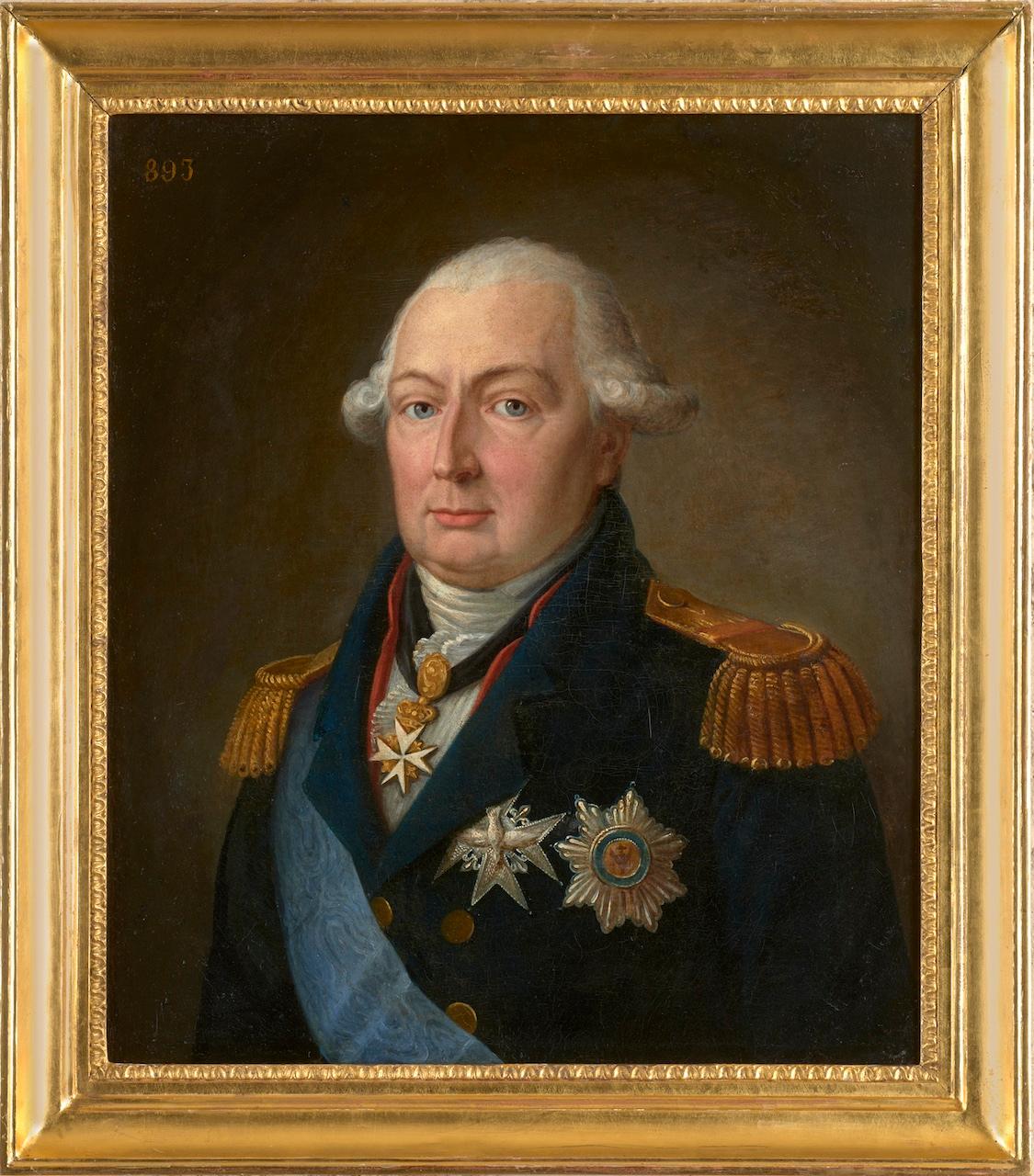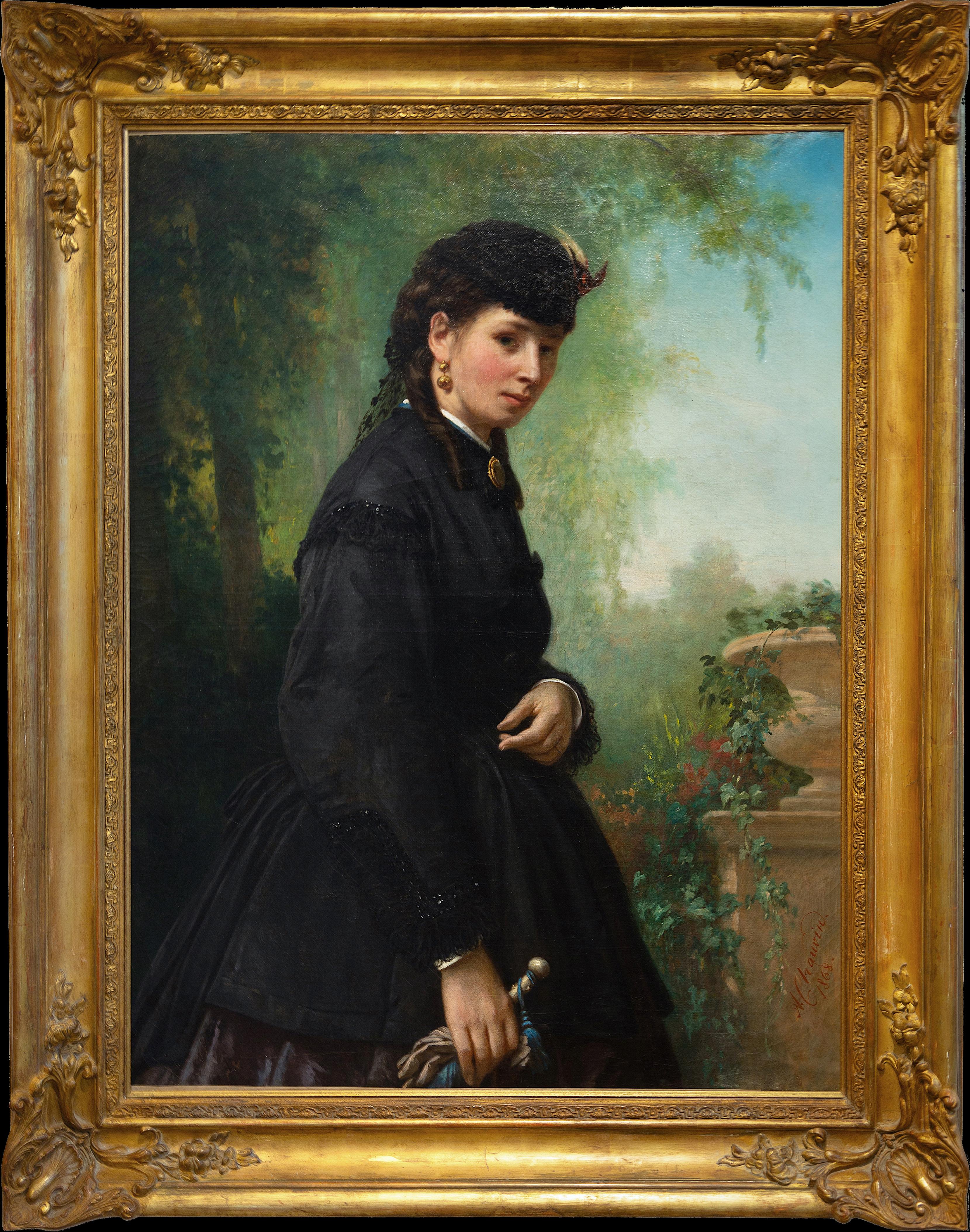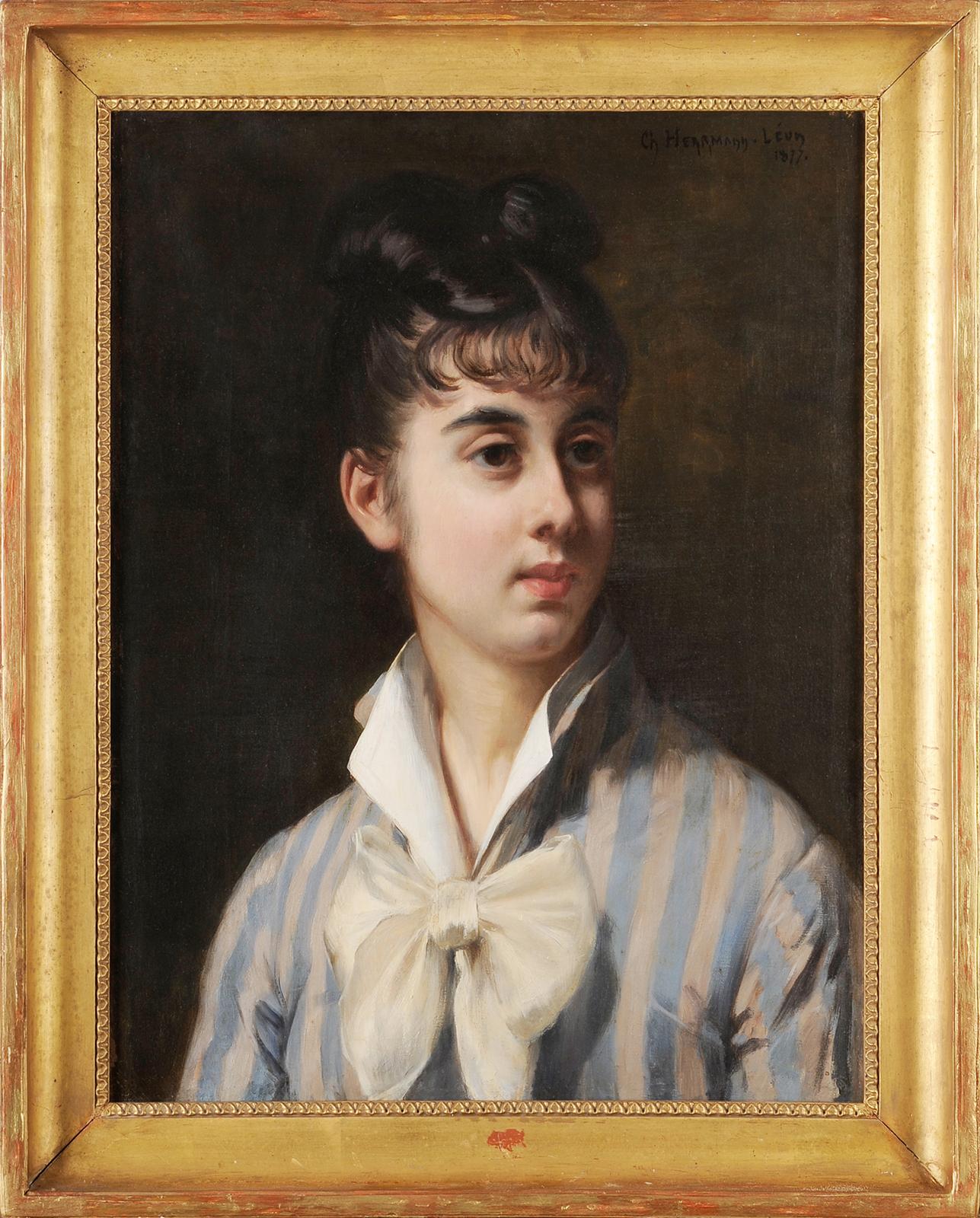Items Similar to Portrait of Jean Claude Pellegrini (1787-1854)
Want more images or videos?
Request additional images or videos from the seller
1 of 4
François Jean SABLETPortrait of Jean Claude Pellegrini (1787-1854)1819
1819
About the Item
François Jean SABLET
(Morges, 1745 – Nantes, 1819)
Portrait of Jean Claude Pellegrini (1787-1854)
Honorary Divisional Inspector of Bridges and Roads.
Oil on canvas
Monogrammed and dated lower right
30x25cm
1819
Painter of portraits, Jean François Sablet, originally from Morges, born November 23, 1745, is the eldest son of Jacob Sablet (1720–1798), bourgeois of this city, house painter, gilder, art dealer, and Suzanne Dupuis (1722–1775), settled in Lausanne from 1754.
In 1767, on June 8, he prepared to leave to “improve in the art of painting” with a viaticum from the Council of Morges and a scholarship from Bern. In Paris, he was a pupil of Joseph-Marie Vien at the Royal Academy (1768–73). In 1772, he was joined by his younger brother Jacques, who in 1776 left for Rome to pursue a brilliant career there. François, he remains in Paris, goes almost unnoticed there having neither competed, nor received a prize, nor even exhibited. In 1774, he signed and dated the Portrait of the Count of Artois, as Colonel-General of the Swiss and Graubünden. In 1777, he married Marie Madeleine Borel, daughter of a wood merchant, and settled near the Quinze-Vingt at the Bastille, as a portrait painter. He entered the Masonic lodge of Celestial Friendship and therefore enjoyed a certain notoriety. He executed the portrait of Charles-Henri, Comte d'Estaing, engraved by Charles-Etienne Gaucher (1779). In 1781, L. Perrot reproduced two of his works from the cabinet of Madame de Saint-Maurice, Childhood in the Countryside and Visit to the Nurse, for the philanthropic society founded in particular by Louis d'Affry, captain of the Swiss Guards. . In addition to the fact that these subjects denote an ideal of benevolence under the aegis of Jean-Jacques Rousseau, they testify to relations with the Swiss milieu. Finally, the format and quality of two large full-length portraits Vestal pouring incense (1781) and the Offering to Hymen (1783) reflect her favor in society on the eve of the Revolution and, although in shadow, he is able to build life annuities. From this first stage are dated two sketchbooks in black chalk and red chalk of characters, interior scenes, theatrical evocations, including the Vestal Virgin pouring incense. He also signed a series of wash illustrations relating to mythology and other subjects taken from Ovid. In 1789, the political climate suddenly darkened, the amateurs left, dragging the artists with them. François Sablet took the road to Switzerland and, in January 1792, joined his brother in Rome, a genre painter in Italian costumes and portraits in nature called "conversation pieces", models from which François was to draw inspiration. François spent the summer in Genzano in the Roman countryside, where he also devoted himself to landscape and popular costumes. Beat d'Hennezel, their compatriot, evokes the evenings at the Sablets' with their artist friends, busy drawing portraits while exchanging heated remarks on the political situation. However, the events in Paris had repercussions in Rome. In January 1793 the French representative was assassinated, the French and other French speakers were in danger and had to leave the Papal States. The artists go back to Florence, but not all of them can stay there and continue to France; the Sablets head for Lausanne. Back in Paris, he was received on October 1, 1793 at the Commune des Arts and on the following May 28, he submitted his sketch of Hay carts dragged by the sans-culottes of the Commune of Chaussière, for lack of horses for the competition of the 'year II. He provided three portraits to the engraver Pierre-Michel Alix for his Galerie des Grands Hommes: Viala, Guillaume Tell and Lycurgue. It was not until 1795 that he exhibited two portraits for the first time at the Salon, then did not sign any more works until 1799. Throughout this period, he lived in Vernonet in Normandy with the actor Simon Chenard and seems to distance himself from Paris unlike his brother who, housed in the Louvre, successfully exhibits his works. In 1799, he presented two landscapes, two interiors and two portraits at the Salon. In 1802, the Piranesi brothers, protected by Lucien Bonaparte, created an Academy of Fine Arts at the College of Navarre, where François Sablet distinguished himself in chalcography: View of the cloister of the Chartreuse in the Baths of Diocletian, Illumination of the Pont des Tuilerie and Illumination of the Concorde and six Views of the gardens of the Villa Borghese. In 1804, he exhibited two landscapes at the Salon, including La Voie Appienne au bas de la Riccia and two portraits.
A decree of March 30, 1805, however, installed the Polytechnic School at the College of Navarre, forcing the Piranesi chalcography to move while granting compensation to the artists. François Sablet then decides to settle in Nantes where he has many friends. It is, in addition to the Cacault brothers with their rich collection in Clisson, the architect Mathurin Crucy, companion of studies, the sculptor François-Frédéric Lemot who creates a new "Arcadie" there, all very close and to the origin of the development of the port and the city of Nantes. François Sablet continued his career as a portraitist there with great success. He has a storefront, everyone parades in his studio, there is a queue. An astonishing production of small portraits “à la Boilly” follows, very natural, sometimes incisive, such as his Self-portrait, dedicated to the Nantes art museum. François Cacault died in 1805 and Sablet was in charge of the inventory of the collection for the museum.
His work, however, is not limited to small portraits: for Crucy, he painted the living room, where the architect and his wife appear, and various landscapes, in particular the Portrait of the de la Roche family, which we do not would not hesitate to attribute to Jacques Sablet. And this is indeed the problem so difficult to elucidate, because not only is François wrongly nicknamed "the Roman" or "the Younger", but he painted in the manner of Jacques. He executed landscapes of the surroundings or souvenirs from Italy, but his main business was the Decoration of the Stock Exchange. Its architect Mathurin Crucy set the program: six large grisailles evoking Napoleon's visit to Nantes in August 1808. François Sablet set to work in July 1810 and the Stock Exchange was inaugurated on August 15, 1812. As for the grisailles they are covered at the Restoration, then removed and sold. All that remains are the preparatory drawings and 123 portraits bequeathed to the Archaeological Society of Nantes in 1862. In April 1817, François exhibited at the Salon a large view of the port of Nantes that he could contemplate from his home. The following year, he signed and dated a Holy Family, the painter's ultimate work. Thus, little by little, the art and personality of François Sablet emerged, essentially a painter of portraits and landscapes, following all styles, flexibly through the vagaries of history, beautiful effigies at the foot of the 'Ancien régime following Vien and small country scenes, fashionable, such as L'escarpolette then converted to Nantes with small portraits illustrating the local bourgeoisie, always knowing how to respond to the various patronages with equal happiness, showing itself to the the height of a major municipal commission such as the decoration of the Stock Exchange, or even rediscovering the style of the Italian 17th century for a church painting.
Museums: Nantes, Brest, Melbourne, New York (Met.), Fribourg, Lausanne…
Bibliography : SIKART - Anne van de Sandt – 1998 and 2018
Jean Claude Frédéric Alexis Pellegrini, born on July 22, 1787 in Chambéry (Mont-Blanc) and died on March 27, 1854, is an honorary divisional inspector of Bridges and Roads. He carried out the works to improve the navigability of the Lot and studied the project for a side channel to the Garonne between Toulouse and the Tarn. He participated in the construction of the Vittorio Emanuele I bridge over the Po in Turin and the bridge over the Garonne in Moissac
He is the son of Bernard Pellegrini, originally from Castelrotto in the town of Croglio, in Ticino (Switzerland), and Marguerite Berthet. He is the brother of Charles Henri Pellegrini.
He entered the polytechnic school on November 20, 1806 and left on September 1, 1808. He entered the public service and continued his studies at the School of Bridges and Roads. During his studies, he did internships in the department of Ain, in 1809, and the department of Po, in Turin, in 1810, where he participated in the work of the great stone bridge over the Po, in Turin. Although he only attended the Ponts et Chaussées school for two years instead of three, he was named an aspiring engineer and remained committed to the construction of the bridge over the Po. He was appointed 2nd class civil engineer on September 1, 1811. In 1812 and 1813, he was in charge of hydraulic works on the Stura. He is responsible for works on the citadel of Turin. His function as military engineer officer ceased after the surrender of the citadel. Then made available to the Ministry of the Interior on May 4, 1814, it was made available to the King of Sardinia to continue work on the bridge over the Po until October 1814. He was then appointed bridge and road engineer in the department of Lozère where he took the necessary steps to build the bridge over the Tarn at Florac. He was appointed department head of a district of the Gers department, between December 1, 1814 and October 1, 1821. He worked on the construction of a three-span stone bridge over the Baïse at Condom. He restored the Gers road network using a process identical to that developed by MacAdam. On October 1, 1821, he was appointed department head of the district of Moissac in the department of Tarn-et-Garonne where he was responsible for the construction of the Moissac bridge. He was appointed 1st class civil engineer on June 1, 1824. On July 15, 1825, he was responsible for completing the canal project between Toulouse and Montauban. He gave the projects for all the works of art to be built with their estimates. On February 6, 1826, he was put in charge of the studies for the lateral canal project on the Garonne between Toulouse and the Tarn. On July 17, 1827, he was appointed interim chief engineer of roads and bridges for the department of Tarn-et-Garonne until the end of October 1828. On October 28, 1828, he was made chief engineer of the Lot department. He was appointed 2nd class chief engineer on October 25, 1829. He was appointed 1st class chief engineer of bridges and roads on August 28, 1835, chief engineer director on June 3, 1839. After 1830, the industrialization of the Aubin-Decazeville basin made necessary the navigability of the Lot, the only waterway allowing the transport of coal and metallurgical products. On November 27, 1832, the Director General of Bridges and Roads entrusted him with the study of the project to improve the navigation of the Lot between Livinhac-le-Haut and the limit of the department of Lot-et-Garonne. These works will begin from 1838 and last until 1848. The spectacular works will be done upstream of Cahors with a series of underground diversion channels like that of Capdenac and narrowing dikes. Pellegrini restored the locks built during the reign of Louis XIV in the lower Lot valley and created new ones with lock dams, ie 74 structures in total. He was retired on November 30, 1845 and appointed honorary divisional inspector. He was naturalized French on July 31, 1816 and made a Knight of the Legion of Honor in 1833.
Bibliography: Biography of Jean Claude Frédéric Alexis Pellegrini, p. 46, in Revue savoisienne, 1906, 46th year
- Creator:François Jean SABLET (1745 - 1819, French)
- Creation Year:1819
- Dimensions:Height: 11.82 in (30 cm)Width: 9.85 in (25 cm)
- Medium:
- Movement & Style:
- Period:
- Condition:
- Gallery Location:PARIS, FR
- Reference Number:
About the Seller
No Reviews Yet
Vetted Seller
These experienced sellers undergo a comprehensive evaluation by our team of in-house experts.
Established in 2014
1stDibs seller since 2022
7 sales on 1stDibs
- ShippingRetrieving quote...Ships From: PARIS, France
- Return PolicyThis item cannot be returned.
More From This SellerView All
- Bust portrait of Louis V Joseph de Bourbon-Condé (1736-1818), prince of CondéLocated in PARIS, FRRosalie GROSSARD (Active at the beginning of the 19th century) Bust portrait of Louis V Joseph de Bourbon-Condé (1736-1818), prince of Condé Oil on canvas mounted on canvas 62.5 x 54 cm 1823 Origin : - Commissioned in 1823 from Rosalie Grossard by Louis-Philippe duc d'Orléans, future king of the French, for the Château d'Eu. - Office of the Duchess of Orléans, née Hélène de Mecklenburg-Schwerin, located on the northern ground floor of the Château d'Eu (1837-1848). - Mentioned on February 4, 1857, under number 385, in the state of the paintings coming from the Château d'Eu and belonging to the widow of King Louis-Philippe, Queen Marie-Amélie, then in exile in England at the château of Claremont. (Arch Nat. Nemours-Chaponay funds from the archives of the Maison de France, 300APIV174) - Given by Queen Marie-Amélie of the French to her son Louis d'Orléans, Duke of Nemours. - By descent - Then former Rohan collection in Vienna. Brands : - Painted on the canvas at the top left the number: 893 (inv. number former Rohan collection, Vienna). - On the back of the canvas: LPO mark under open crown of Prince of France for the collections of Louis-Philippe Duke of Orléans...Category
Early 19th Century French School Portrait Paintings
MaterialsOil
- Presumed portrait of Athanase Peltier in front of the Fort of Ham - FranceLocated in PARIS, FRÉdouard Henri Théophile PINGRET (Saint-Quentin, 1785 – Paris, 1869) Presumed portrait of Athanase Peltier in front of the Fort of Ham Oil on canvas Signed and dated lower left 40.5...Category
Early 19th Century French School Portrait Paintings
MaterialsOil
- Portrait of a girlLocated in PARIS, FRGermain PAGET (Morbier, 1817 – Morbier, 1884) Portrait of a girl Oil on canvas Signed lower right 65 x 54cm Germain Paget was born in Morbier on May 18, 1817, second in a family o...Category
Mid-19th Century French School Portrait Paintings
MaterialsOil
- Young boy with tarboucheLocated in PARIS, FRThéophile Constant CASTAN (Millau, 1814 – Fontainebleau, 1878) Young boy with tarbouche Oil on canvas Signed and dated lower left 46x41cm 1847 Son of Pier...Category
Mid-19th Century French School Portrait Paintings
MaterialsOil
- Portrait of a child with blue eyesBy Charles Zacharie LandelleLocated in PARIS, FRCharles Zacharie LANDELLE (Laval, 1821 – Chennevières/Marne, 1908) Portrait of a child with blue eyes Oil on canvas Monogrammed and dated lower l...Category
Mid-19th Century French School Portrait Paintings
MaterialsOil
- Mignon regretting his homeland - Mignon aspiring to heavenLocated in PARIS, FRAry SCHEFFER (1795-1858), workshop of Mignon regretting his homeland Mignon aspiring to heaven Two oils on canvas in the same frame 44 x 22 cm each Mig...Category
Mid-19th Century French School Figurative Paintings
MaterialsOil
You May Also Like
- Declaration of Adultery with Bailiff Oil on CanvasLocated in Pasadena, CAOil on canvas probably representing a finding of adultery at the end of the 19th century. The scene is painted with many details in a camaieux of gray colors . The edges of the paint...Category
Late 19th Century French School Figurative Paintings
MaterialsOil
- Fine Antique French Signed Oil Painting Portrait Young Lady in TurbanLocated in Cirencester, GloucestershirePortrait of a Young Lady wearing pink and a Turban headpiece by Henri-Charles Daudin (1864-1917, French) signed oil on wood panel, unframed board: 14 x 10.5 inches provenance: privat...Category
Late 19th Century French School Portrait Paintings
MaterialsOil
- Women portrait (Coraline)Located in BELEYMAS, FRAuguste Adolphe CHAUVIN (Liege, 1810 – Liege 1884) Portrait of Coraline Oil on canvas Signed and dated lower right 91 x 68 cm 1868 Auguste Adolphe Chauvin, born in Liège on October ...Category
1860s French School Figurative Paintings
MaterialsCanvas, Oil
- Young woman portrait with a white bowLocated in BELEYMAS, FRCharles HERMANN-LÉON (born Léon Charles Sigismond HEMRMANN) (Le Havre 1838 - Paris 1908) Portrait of a young woman Oil on canvas H. 54 cm; L. 41 cm Signed and dated upper right - 187...Category
1870s French School Figurative Paintings
MaterialsOil, Canvas
- Four large family portraitsLocated in BELEYMAS, FRSuite of four large family portraits, kept together to this day. Created around 1840 by the painter Théophile Morel, who presented portraits at the Salon des Artistes Français from t...Category
1840s French School Figurative Paintings
MaterialsOil, Canvas
- Presumed portrait of Baron de VennacLocated in BELEYMAS, FRMarianne LOIR (Paris 1705 – Paris 1783) Presumed portrait of Jean-Jacques-Blaise Baloin de Belvèse, Baron de Vennac (?-1781) Oil on oval canvas H. 54.5 cm; W. 46 cm (around 90 cm hig...Category
1770s French School Figurative Paintings
MaterialsOil, Canvas
Recently Viewed
View AllMore Ways To Browse
Set Of Portraits
Cover Portrait
Painting Portrait Nature
Very Large Portrait
Portrait Of Actor
Portrait Of Rome
Jean So
Portrait Daughter
Period Portraits Framed
Large French Portrait
Portrait Of An Actor
Italian School Portrait
Business Portrait
End Of History
Antique Style Portraits
Switzerland Portrait
Large Antique Portrait
Louis Portrait



